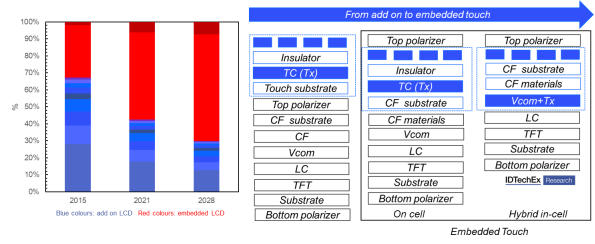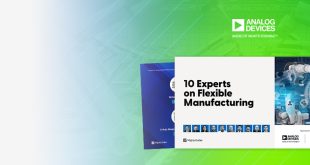ITO alternative (TCFs) are no longer a young technology. They have been in the semi commercial mode for more than a decade and half. In that time, they have often come tantalising close to success, and in some instances, even carved out niche markets. Yet, they are still hoping for that great breakthrough. So why has the commercialisation process been prolonged for so long?
In this article we will provide an answer from the perspective of technology change. We will argue that TCFs have been out of synch- either too early or too late- with technology transitions. This analysis is drawn from the IDTechEx Research report Transparent Conductive Films and Materials 2018-2028: Forecasts, Technologies, Players which provides detailed technology assessment for all established and emerging transparent conductor layer technologies, we offer ten-year market forecasts in sqm and value segmented by 20 applications and 10 technologies. We also cover more than 90 companies in the field.
Flexible displays: market success for ITO alternatives?
The primary market for TCFs is touch displays and a major trend in the display industry has been the rise of robust, flexible and rollable screens. This technology frontier has been in the making for many years and it is now finally on the cusp of commercial success. This is because the different pieces of the puzzle are finally fitting together: rigid plastic OLED displays have been on the market since around 2014 and now both the thin film encapsulation technology and LTPS (or other backplane tech) on PI are becoming increasingly flexible (not just plastic based).
This trend towards flexibility has long been considered as the ultimate panacea for ITO alternatives since ITO films fail if bent too much and/or too many times. Indeed, it is this prospect that has long motivated large swathes of the industry for years. So, now that we are so close to commercialisation of flexible OLED displays, why is there no unrestrained euphoria?
The answer is that ITO alternative films are now concerned that they will turn out just to be a temporary solution, a mere space holder until an ultra-thin embedded solution is readied when the right production yield is achieved. We will explain the trends in in the next few paragraphs.
Consider the image below. It shows that rigid plastic displays mainly utilise ITO films. This limits flexibility therefore needs to give way to a flexible alternative. Therefore, many are exploring the use of ITO alternative films, all of which are flexible. Here, these alternative films compete on performance (sheet resistance, transparency, haze, etc), degree of flexibility, and cost. Currently, the likely leading winners include Ag nanowires and even some metal mesh films.

There are however already clear indications that film-based add-on implementation will not be the end game. This is because embedded in-house-made flexible touch sensors are already demonstrated by several display makers. In fact, a version is already commercialised by a leading OLED display producer.
As shown in the image, in the embedded implementation, the display makers manufacture the touch layers on the conformal multilayer top barrier. The touch sensor is deposited using tools such as evaporation and sputtering, and is made up of metals such as TiOx etc. It is thus a form of embedded inhouse-made metal mesh, but not metal mesh film.
This technology requires expertise (thus extensive in-house learning curve) and the allocation of expensive in-house assets to touch screen production. It also requires careful process control so as not to damage the underlying encapsulation layer. In addition to production complexity, its commercial spread to more display makers might also be hampered by IP issues.
This embedded technology however will likely win on one key attribute: thinness which also determines the degree of flexibility. It achieves such thinness especially by eliminating the transparent conductive film and the adhesives (i.e., TCF and OCA). It can also be furthered thinned by interweaving the touch structure with the inline thin film encapsulation layers. This approach is not yet commercial, but patent trends suggest it is of active interest.
Consequently, flexible TCF films risk being cut out of the market if the technology transitions from add-on to embedded touch in flexible displays. Note that a similar transition has already taken place in rigid LCD displays, adversely affecting the market for film supply. The main losers of such technology shifts have been the film makers and touch integrators.
What to do?
These transitions are nothing new for the touch screens which throughout its history has had to contend with rapid and significant technology changes. Indeed, the industry knows that it must make hay when the sun shines as every few quarters there might be major technology transitions. In the short term the transition towards flexibility displays will bring benefit- in terms of new touch technologies and integration/laminations expertise- but in the long term the road will be more turbulent.

In any case however it will be more probable that we will witness a long and gradual transition towards true embedded integration. During this process, there will be a varied technology mix, keeping the market open for ITO alternative films. This will be the case because not every company will have the expertise and/or the legal right to do true embedded implementation, whilst add-on will find ways to stay competitive by offering a better cost position and just-about-enough performance for displays not requiring low bending radiuses.
The various makers will need to offer multiple-function-in-one TCFs meaning that the TCF could be combined with colour filters, polarizer or barrier films, thus saving thinness. In the longer term various transparent conducting technologies may adopt to changing trends. In particular, materials (not films) such as silver nanowires might be used in the inhouse embedded process if they are conformal, ultra-thin, high performance and can be easily photo patterned or if various technologies can be directly printed on the barrier structure. This indeed is essentially what has happened to metal mesh in current embedded on-TFE touch. This development might allow these technologies to stay relevant but will require further R&D.
Beyond displays: breaking out of the purgatory?
At the start we mentioned that TCF technologies are out of synch with technology development. In case of flexible displays, they might have to forever play catch up. In case of other addressable markets however the waiting game goes on
Take (1) flexible organic photovoltaics (OPV) and (2) flexible OLED lighting as examples. Both technologies need flexibility to differentiate and to be commercialised. As such, they will likely eventually need ITO alternatives. In the case of OPV, companies are finally selling parts of their narrow-web R2R solution processing capacity with some contemplating a transition to wide web production. In case of OLED lighting, some producers have transitioned to S2S Gen5 production whilst investment in wide-web R2R production was also made some years ago. Despite this progress, the challenge is that both OPVs and OLED lighting remain underperforming and overpriced compared to the incumbent Si PV and inorganic LED lighting. As such, there is still much work to do to bring commercial success and thus the wait for all device component suppliers- including TCFs- goes on.
Consequently, TCFs are caught in a purgatory when it comes to these applications. It can not leave the space because every opportunity is important to the industry and it is unable to proceed because the end market is not quiet commercially ready. The waiting game therefore will go on in the short to medium term. However, as this IDTechEx Research report shows, we believe that these and similar applications will arrive. Indeed, we estimate that emerging applications (vs those established today) will come to represent more than 50 per cent of the market in 2028 (up from <10 per cent today).
To learn more please read the IDTechEx Research report Transparent Conductive Films and Materials 2018-2028: Forecasts, Technologies, Players. It provides detailed technology assessment for all established and emerging transparent conductor layer technologies such as ITO, Ag NW, metal mesh (printed, etched, hybrid/embossed, print-plate, etc), CNTs/CNBs, graphene, PEDOT, etc). It offers ten-year market forecasts in sqm and value segmented by 20 applications and 10 technologies. We also cover more than 90 companies in the field.
 CIE Components in Electronics
CIE Components in Electronics


